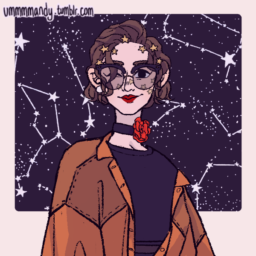The short answer to “why write a game about Homestuck” is “because I wanted to write a game with classpects and strife specibi and I enjoy inflicting pain on my friends by reminding them of Homestuck’s continued existence”.
Here’s the long answer: whether I like it or not, Homestuck was a really important influence on my life and my work as an artist. I found Homestuck during a very weird time in my life and read it on my school’s computers and at friends’ houses during the start of my junior year of high school. The chaos of the storyline, the double mobius reacharound of the timeline, and the memorable character design stuck with me for some reason. Being a part of Homestuck fandom, as tangentially as I was, was easily the most toxic time in my internet life (and I was a Superwholock for several years). But I also developed as a visual artist in ways I could never have anticipated before. I learned how to draw people— and I enjoyed it!
Ex-Homestucks often joke they’ll never be free of the webcomic and that is true. It’s been however many years. I sat through the bloodiest event in web original history to ever be retconned. I hit the finale and the final snapchats and I have closed that chapter on my life. And yet I wrote a game and published it on 4/13 because I live to make my friends groan at me.
What I really wanted to do was to make a game about fighting back against a prescribed tragic ending; about finding light and joy when it seems all hope is lost; and bonds of friendship that transcend the boundaries between worlds (or the walls of your house). I wasn’t planning on releasing the game mid-pandemic, where players would not be able to join up with each other and play in person for quite some time, but sometimes the world works in ways you don’t expect.
When I play games that involve combat and other actions to be left to random chance, I often hear someone explain a really really great move that makes everyone scream and I wish it could automatically succeed. I have almost never seen a GM allow that, and that’s what gave me the idea for the auto-success mechanic in the game. I want players to go as batshit as possible with their actions to get emotional responses from their fellow players. If you can make someone laugh or cheer with your move, if you land a particularly horrible pun, I want there to be an influence on the narrative.
This also applies to the auto-rez mechanic I wrote. Anyone who’s played any sort of game with me knows that I fully believe that character death is, quite frankly, overused as a cop-out punishment for bad rolls. There are very few instances where I think that a character’s death is the right narrative choice— I can’t think of any examples off the top of my head, which is how you know how little I care for the trope. That doesn’t change the fact that sometimes, shit happens. And when you’re dealing with characters or people you care about dying, potentially never to be seen again… Games get high stress. Sometimes you cry about it.
If someone is going to miss you— genuinely miss you— to the point where their actual player gets upset about it, first of all please take care of your friend if you can. Bleed sucks. Second of all if you’re not using your character’s death as the culmination of an important arc for them (which is absolutely a choice that I respect when it’s intentional— I may not like it but I can respect it) or some other reason, take a move from Interstitial’s book and have your character come back when the danger has passed, totally fine! Hey, maybe you have god-like powers now!
The last point I want to make here (because these statements are becoming essays and I may have to figure out how to distill them down if I want them to be true “artist statements”) is building off of Delver while also shedding much of the mechanics of Delver proper. I’m an ardent admirer of Natalie the Knife’s work, and I think Delver and its truly-gmless version Worm Spring are some of the greatest dungeon crawlers to be made. Building it’s going to be a long day off of Delver was a decision I made early in development, back when it was a project I was still collabing on with Ben (shoutouts to Ben and Natalie for helping me with the classpect keywords) and I honestly don’t remember anymore what the original notion was. As development continued I wanted to keep the rotating phases of the game (shifting between waking and dreaming worlds) intact while also not prescribing to the players how they should go about building to the next planet, or talking to denizens, or even dreaming.
This game, much like sburb, really works best when it feels and functions like Calvinball. All I do is provide the guidelines, the worlds, and the contexts; it’s up to you to decide what to do with that infinite font of creativity.
(for more of my artist statements, follow this link)
